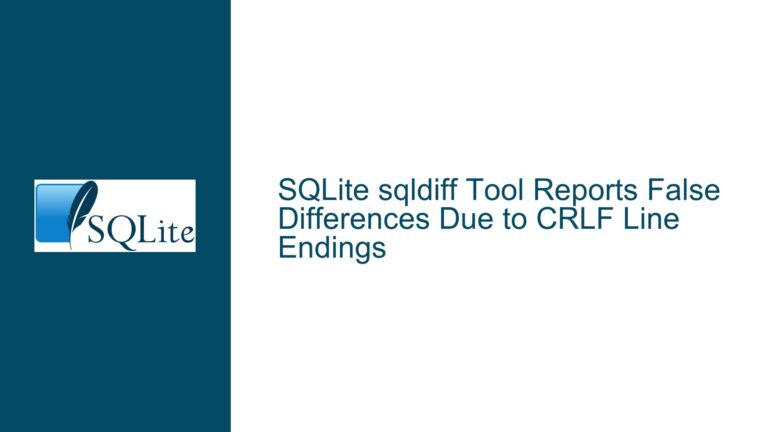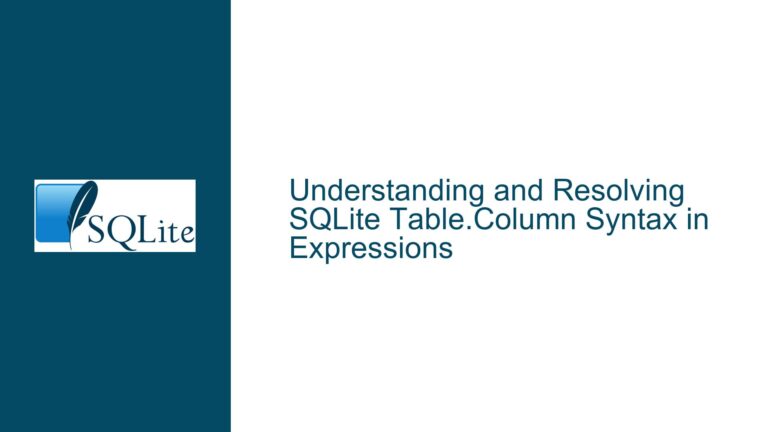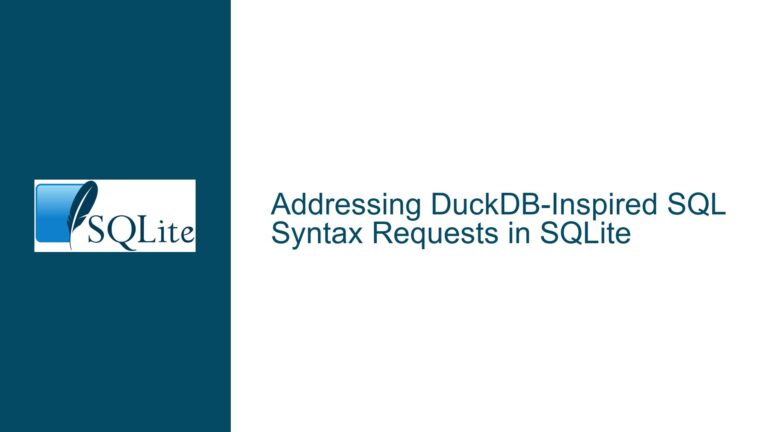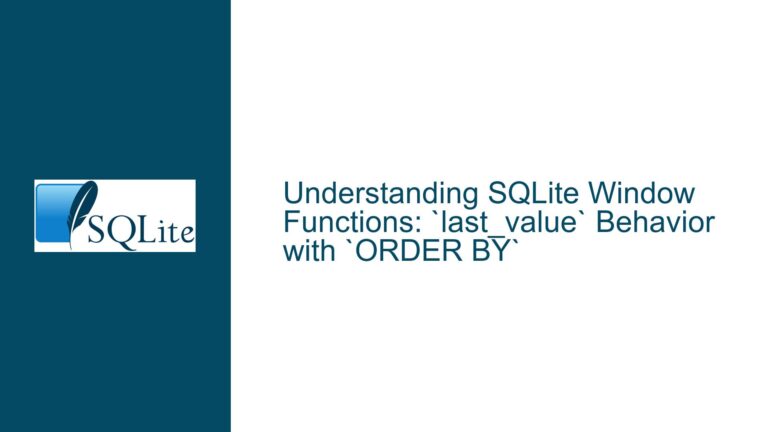Data Misalignment During Cross-Database INSERT Due to Column Order Mismatch
Schema-Driven Column Binding in SQLite INSERT Operations
Core Mechanism of Column Position Dependency
The fundamental challenge arises when transferring rows between two SQLite database files ("old.db" and "new.db") where identically named columns in the source and target tables are declared in different orders. SQLite relies on positional column binding during INSERT ... SELECT operations rather than name-based alignment. This means:
- The
SELECT *operator returns columns in the physical storage order defined by the source table’s schema. - The
INSERT INTO target_tablecommand maps these columns to the target table’s schema by position, ignoring column names.
In the provided scenario:
- Source schema (old.db):
POINTS(id, x, y) - Target schema (new.db):
POINTS(id, y, x)
Using INSERT OR REPLACE INTO new.points SELECT * FROM main.points binds:
old.db.x→new.db.yold.db.y→new.db.x
This results in swapped values for the x and y columns in the target database.
Failure Modes in Implicit Column List Reliance
The root cause is not a bug in SQLite but a design characteristic of its data manipulation engine. Key factors include:
Positional Binding as Default Behavior:
SQLite adheres strictly to column order when using wildcard (*) operators or omitting explicit column lists. This is consistent with ANSI SQL standards but becomes hazardous when schemas evolve asymmetrically.Schema Versioning Risks:
When tables undergo structural changes (e.g., column reordering, additions, or deletions), implicitSELECT *andINSERT INTO tablestatements become fragile. The absence of column name validation during insertion allows silent data corruption.Primary Key Handling:
TheINSERT OR REPLACEcommand complicates matters further by using the target table’s primary key to determine conflict resolution. If the primary key column (e.g.,id) is correctly aligned, the operation will overwrite rows without errors, masking the misaligned non-key columns.
Strategic Column Enumeration for Schema-Agnostic Transfers
Step 1: Validate Source and Target Column Orders
Before executing any transfer, explicitly verify the column order of both tables using:
PRAGMA table_info(points);
Run this against both the main (source) and attached (target) databases. Compare the cid (column ID) values to identify discrepancies.
Step 2: Refactor Queries with Explicit Column Lists
Replace all instances of SELECT * and implicit INSERT column lists with fully qualified enumerations:
Incorrect Approach:
INSERT OR REPLACE INTO new.points SELECT * FROM main.points;
Correct Approach:
INSERT OR REPLACE INTO new.points(id, y, x)
SELECT id, y, x FROM main.points;
This ensures:
- The
idcolumn (primary key) is preserved for conflict resolution. yandxvalues are explicitly mapped from the source to the target’s schema.
Step 3: Implement Schema Validation Checks
Embed sanity checks into migration scripts to detect schema mismatches proactively:
-- Check if source and target have the same number of columns
SELECT
(SELECT COUNT(*) FROM pragma_table_info('main.points')) AS source_col_count,
(SELECT COUNT(*) FROM pragma_table_info('new.points')) AS target_col_count;
-- Check if specific column names exist in target
SELECT name FROM pragma_table_info('new.points')
WHERE name NOT IN ('id', 'x', 'y');
Step 4: Use Temporary Intermediate Tables
For complex migrations, stage data in a temporary table that mirrors the target schema:
ATTACH DATABASE 'new.db' AS new;
-- Create temp table matching target schema
CREATE TEMP TABLE migration_buffer (
id INTEGER PRIMARY KEY,
y INTEGER,
x INTEGER
);
-- Populate with explicit column mapping
INSERT INTO migration_buffer(id, y, x)
SELECT id, y, x FROM main.points;
-- Transfer to target
INSERT OR REPLACE INTO new.points
SELECT * FROM migration_buffer;
DROP TABLE migration_buffer;
Step 5: Leverage SQLite’s Backup API for Structural Copies
When entire tables need to be replicated with identical schemas, use SQLite’s built-in backup API via the sqlite3 shell:
sqlite3 new.db "ATTACH 'old.db' AS old;
BEGIN;
DELETE FROM main.points;
INSERT INTO main.points SELECT * FROM old.points;
COMMIT;"
Warning: This method only works if both tables have identical column orders and compatible schemas.
Advanced Mitigation: Schema Harmonization Techniques
Column Renaming:
If possible, rename columns in the target schema to match the source order:ALTER TABLE new.points RENAME COLUMN y TO x_temp; ALTER TABLE new.points RENAME COLUMN x TO y; ALTER TABLE new.points RENAME COLUMN x_temp TO x;View-Based Abstraction:
Create a view in the target database that reorders columns to match the source schema:CREATE VIEW new.points_compat AS SELECT id, x, y FROM new.points;Then insert into the view:
INSERT OR REPLACE INTO new.points_compat SELECT * FROM main.points;Dynamic SQL Generation:
For programmatic solutions, queryPRAGMA table_infoat runtime to generate explicit column lists:import sqlite3 def get_column_list(conn, table): cursor = conn.execute(f"PRAGMA table_info({table})") return [row[1] for row in cursor.fetchall()] source_conn = sqlite3.connect('old.db') target_conn = sqlite3.connect('new.db') source_cols = get_column_list(source_conn, 'points') target_cols = get_column_list(target_conn, 'points') # Ensure same columns exist in both tables assert set(source_cols) == set(target_cols), "Schema mismatch" # Build explicit INSERT ... SELECT query query = f""" ATTACH DATABASE 'new.db' AS new; INSERT OR REPLACE INTO new.points({', '.join(target_cols)}) SELECT {', '.join(source_cols)} FROM main.points; """ source_conn.execute(query) source_conn.commit()
Philosophical Considerations in SQLite’s Design
SQLite prioritizes performance and simplicity over protective safeguards. The expectation is that developers:
- Understand the structural dependencies of their schemas.
- Avoid implicit column lists in production code.
- Treat
SELECT *as a debugging/exploratory tool, not a deployment-grade solution.
This design aligns with SQLite’s role as an embedded database, where schema changes are typically tightly controlled by the application layer.
Final Recommendations
- Explicit > Implicit: Always specify column lists in
INSERTandSELECTclauses for data migration tasks. - Schema Checks: Use
PRAGMA table_infoto programmatically verify column orders before transfers. - Isolation Layers: Utilize temporary tables or views to decouple source and target schemas.
- Documentation: Annotate schema changes with migration scripts that include explicit column mappings.
- Testing: Implement unit tests that compare pre- and post-migration row contents using checksums or spot checks.
By adhering to these practices, developers can leverage SQLite’s flexibility while avoiding data misalignment pitfalls during cross-database operations.






